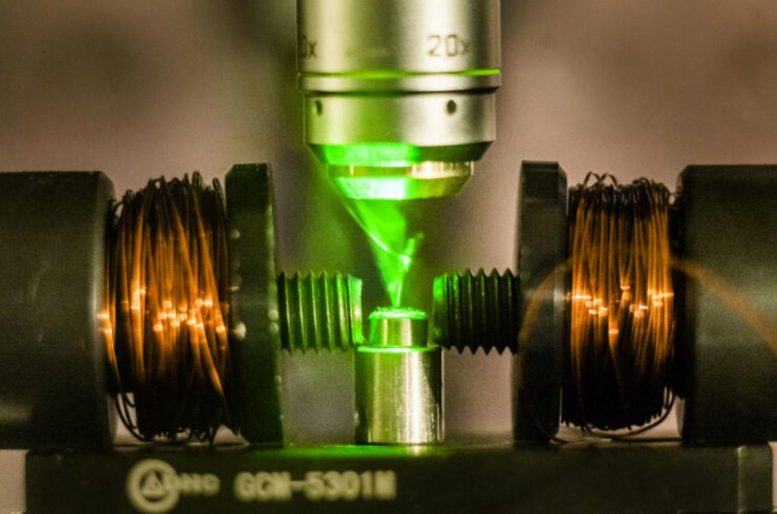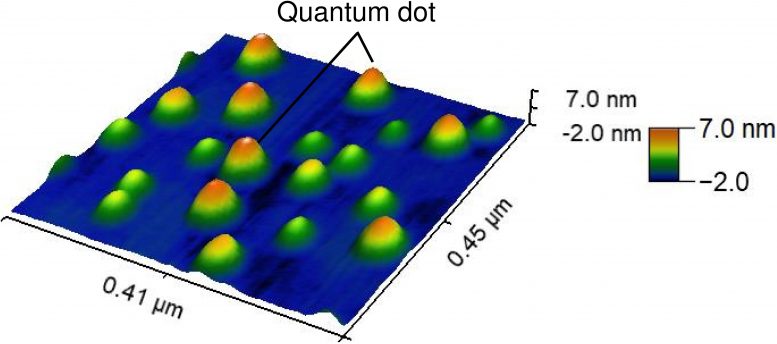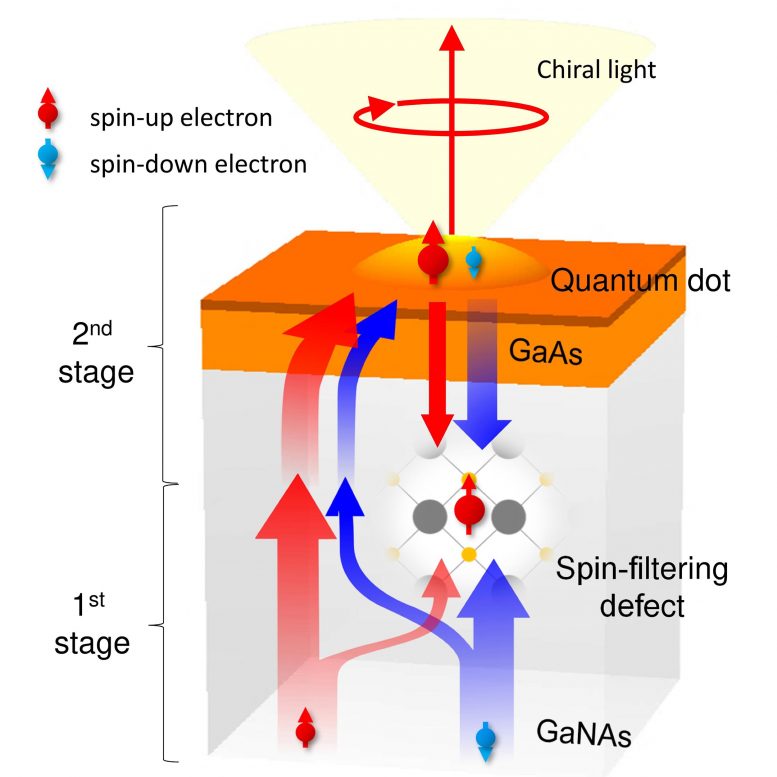
Experimental setup similar to the one the researchers have used. Credit: Thor Balkhed
It may be possible in the future to use information technology where electron spin is used to process information in quantum computers. It has long been the goal of scientists to be able to use spin-based quantum information technology at room temperature. Researchers from Sweden, Finland and Japan have now constructed a semiconductor component in which information can be efficiently exchanged between electron spin and light – at room temperature and above.
It is well known that electrons have a negative charge, and they also have another property, namely spin. The latter may prove instrumental in the advance of information technology. To put it simply, we can imagine the electron rotating around its own axis, similar to the way in which the Earth rotates around its own axis. Spintronics – a promising candidate for future information technology – uses this quantum property of electrons to store, process, and transfer information. This brings important benefits, such as higher speed and lower energy consumption than traditional electronics.

Weimin Chen, professor at Linköping University. Credit: Peter Modin/LiU
Developments in spintronics in recent decades have been based on the use of metals, and these have been highly significant for the possibility of storing large amounts of data. There would, however, be several advantages in using spintronics based on semiconductors, in the same way that semiconductors form the backbone of today’s electronics and photonics.
“One important advantage of spintronics based on semiconductors is the possibility to convert the information that is represented by the spin state and transfer it to light, and vice versa. The technology is known as opto-spintronics. It would make it possible to integrate information processing and storage based on spin with information transfer through light”, says Weimin Chen, professor at Linköping University, Sweden, who led the project.
As electronics used today operates at room temperature and above, a serious problem in the development of spintronics has been that electrons tend to switch and randomize their direction of spin when the temperature rises. This means that the information coded by the electron spin states is lost or becomes ambiguous. It is thus a necessary condition for the development of semiconductor-based spintronics that we can orient essentially all electrons to the same spin state and maintain it, in other words that they are spin polarized, at room temperature and higher temperatures. Previous research has achieved a highest electron spin polarization of around 60% at room temperature, untenable for large-scale practical applications.
Researchers at Linköping University, Tampere University and Hokkaido University have now achieved an electron spin polarization at room temperature greater than 90%. The spin polarization remains at a high level even up to 110 °C. This technological advance, which is described in Nature Photonics, is based on an opto-spintronic nanostructure that the researchers have constructed from layers of different semiconductor materials (see description below the article). It contains nanoscale regions called quantum dots. Each quantum dot is around 10,000 times smaller than the thickness of a human hair.

The quantum dots in the opto-spintronic nanostructure are made from indium arsenide (InAs). Each quantum dot is around 10,000 times smaller than the thickness of a human hair. Credit: Yuqing Huang
When a spin polarized electron impinges on a quantum dot, it emits light – to be more precise, it emits a single photon with a state (angular momentum) determined by the electron spin. Thus, quantum dots are considered to have a great potential as an interface to transfer information between electron spin and light, as will be necessary in spintronics, photonics and quantum computing. In the newly published study, the scientists show that it is possible to use an adjacent spin filter to control the electron spin of the quantum dots remotely, and at room temperature.
The quantum dots are made from indium arsenide (InAs), and a layer of gallium nitrogen arsenide (GaNAs) functions as a filter of spin. A layer of gallium arsenide (GaAs) is sandwiched between them. Similar structures are already being used in optoelectronic technology based on gallium arsenide, and the researchers believe that this can make it easier to integrate spintronics with existing electronic and photonic components.
“We are very happy that our long-term efforts to increase the expertise required to fabricate highly-controlled N-containing semiconductors is defining a new frontier in spintronics. So far, we have had a good level of success when using such materials for optoelectronics devices, most recently in high-efficiency solar-cells and laser diodes. Now we are looking forward to continuing this work and to unite photonics and spintronics, using a common platform for light-based and spin-based quantum technology”, says Professor Mircea Guina, head of the research team at Tampere University in Finland.
What is spintronics?
Spintronics is a technology that uses both the charge and the spin of electrons to process and carry information.
The spin of an electron can be envisioned as arising when the electron rotates clockwise or anticlockwise around its axis, in the same way that the Earth rotates around its axis. The two directions of rotation are called “up” and “down”. In the electronic technology used today, the electron charge is used to represent 0 and 1, and in this way carry information. In a corresponding way, the information can be represented in spintronics using the spin state of the electrons.

In the opto-spintronic nanostructure, an electron spin polarization degree greater than 90% is achieved at room temperature in a quantum dot, via remote defect-enabled spin filtering through an adjacent layer of gallium nitrogen arsenide (GaNAs). When such a spin polarized electron recombines, it emits chiral light. The spin state of the electron determines whether the electromagnetic field of the light will rotate clockwise or anticlockwise around the direction of travel. Credit: Yuqing Huang
In the world of quantum physics, an electron can possess both directions of spin at the same time (and thus be in a state that is a mixture of 1 and 0). This is, of course, completely unthinkable in the traditional, “classical” world, and is the key to quantum computing. Spintronics is therefore promising for the development of quantum computers.
Opto-spintronics involves transferring the information that is represented by the spin state of the electrons to light, and vice versa. The light, photons, can then carry the information onwards through optical fibers, very rapidly and across long distances. The spin state of the electron determines the properties of the light, or to put it more accurately, it determines whether the electromagnetic field of the light will rotate clockwise or anticlockwise around the direction of travel, in roughly the same way that a corkscrew can have a clockwise or anticlockwise direction of turn.
Source: Weimin Chen, professor at Linköping University
Reference: “Room-temperature electron spin polarization exceeding 90% in an opto-spintronic semiconductor nanostructure via remote spin filtering” by Yuqing Huang, Ville Polojärvi, Satoshi Hiura, Pontus Höjer, Arto Aho, Riku Isoaho, Teemu Hakkarainen, Mircea Guina, Shino Sato, Junichi Takayama, Akihiro Murayama, Irina A. Buyanova and Weimin M. Chen, 8 April 2021, Nature Photonics.DOI: 10.1038/s41566-021-00786-y
Financial support for the research has been granted by, among other bodies, the Swedish Research Council, the Swedish Foundation for International Cooperation in Research and Higher Education (STINT), the Swedish Government Strategic Research Area in Materials Science on Functional Materials at Linköping University, the European Research Council ERC, the Academy of Finland, and the Japan Society for the Promotion of Science.